Faraday report to Trinity House 28 August 1840
Report of Professor Faraday, on the comparative qualities of Refractors of English and French Manufacture.- dated August 1840.
To the Master, Deputy Master1, and Elder Brethren of the Trinity House.
My Lords and Gentlemen.
38. I have, according to the instructions I received, carefully examined and compared certain refractors, by the general practical method described in the “Suggestions” of the 23rd July2 and proceed to state the results. The refractor, which, for the present, I adopted as a standard, was that of French manufacture in the room at the Trinity House. Those compared with it, were the English 1st Class refractor and two 2nd Class refractors in the same room, and, also, three frames, now numbered 53. 54. and 58. in the Gibraltar apparatus at present at Mr. Wilkins manufactory.
39. The focal test object which I have used, has been a white area, 1 inch in horizontal length, and a quarter of an inch high, upon a black Ground <(21)>. Another object, which by day light examination will in some cases be superior, was also used and consisted of an inch in length of plated cylindrical wire about ¼ of an inch in diameter fixed on a black card. This yields a horizontal line of light important for some cases but almost too delicate for common purposes.
40. The French refractor consists of four vertical columns or divisions which may be called from left to right, I. II. III. IV.; and these being examined separately, give four specimens of French work, or four standards.

The accompanying diagram gives the profile of this refractor, with the ribs numbered. The object was placed at the given focal distance of 36½ inches from the refractor and observed from the distance of 20 feet in the manner already described (16. 18. &c.); and the following are the results.
41. Division I. As the eye, placed at the horizontal distance of 20 feet, rose, the object appeared in the ribs in the following order 1. 2. 3. 4. 6. 5. 8. 7. 9; as the eye descended from 1, the order was 1. 12. 13. 14. 15. 18. 16. 17. 19. So the ribs 6. 8. and 18 threw their rays out of order.
42. As the eye moved the image of the object entered and left the ribs in the right direction, except in 18 and 19;- thus, as the eye ascended, the object entered in at the bottom of any particular rib; and as the eye descended it entered at the top (16. 18.). This I will call direct entrance, and the contrary as in 18. and 19. reverse entrance. The effect shews that the rays from the ribs having direct entrance do not converge to a second focus at a distance of 20 feet or less. Reverse entrance shews that the rays from the rib do cross between the refractor and the eye of the observer (71.).
43. Division II. As the eye rose, the object appeared in the ribs in the following order, 1. 2. 3. 9. 4. 6. 5. 7. 8. In descending the order was 1. 12. 13. 14. 16. 15. 18. 17. 19. So ribs 9. 6. 16. and 18., give rays crossing other beams. The object entered and left each particular rib on the right edge or with direct entrance except in ribs 8. 17 and 18.
44. Division III. The object entered the ribs in succession thus; 1. 2. 3. 4. 5. 6. 7. 8. 9. - 1. 12. 13. 14. 15. 16. 17. 18. 19. Thus the order was right; and the entrance into each particular rib was direct except in rib 9.
45. Division IV. The order of entrance was 1. 2. 3. 4. 5. 7. 6. 8. 9. and 1. 12. 13. 14. 15. 16. 17. 18. 19. So 7 is out of place; and in rib 5 the entrance was reverse.
46. As a general remark, I may here observe that the forms of the object in the different parts of the refractor were generally very fair; i.e. they were regular, not appearing distorted, or in the top and bottom of a particular rib before it appeared in the middle.
<-><-><->
47. In proposing a practical examination of these refractors, my desire is to offer one the results of which may be recorded on paper so that if appealed against, it may be repeated, and the first result corrected or confirmed. In this way it will not be the authority of personal character that will approve or condemn, but the facts of the case. To obtain such a result I will offer a few words of explanation and the following diagram.
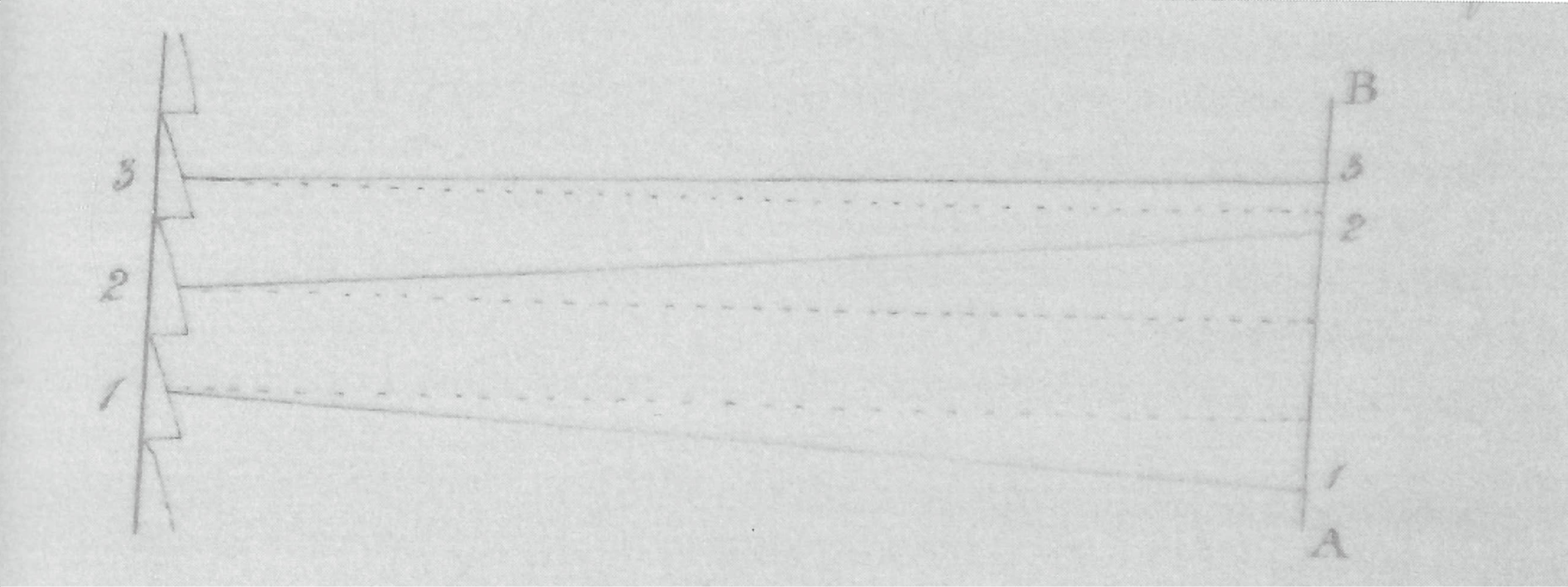
If, as the eye ascended from A to B at the distance of 20 feet, the object appeared in the order 1. 2. 3. &c: (18. 41) it would shew that the rays from ribs 1. 2. and 3 did not meet or cross within that distance; but the record would not tell whether the rays from these different ribs converged, or diverged, or were parallel, as they ought to be, to a horizontal line. To obtain, therefore, such a result, I adopted the following plan.
48. The refractor being perfectly vertical, and the object adjusted correctly in the given focus both as to height and distance, a stand was placed 20 feet from it, on which was drawn the profile of the refractor, so that a line drawn horizontally from any given rib fell accurately on its corresponding place on the profile; thus such a line from the middle of the fifth rib fell on the middle of the fifth space. A sliding eye piece moved on the stand and could be adjusted or set so that the eye looking through it could see the image of the object in any particular rib. Generally, the eye could see this image whilst the eye piece moved through a space of 2 inches or more up to 12 or 14 inches; the medium ray therefore of the bundle issuing from any particular rib was chosen to represent that rib. Thus, if it was rib 6 that had to be observed, the eye piece was moved until the object appeared in the middle of the rib; in which case if the eye was moved above and below the eye piece, (and the rib at all regular in shape) the object disappeared at equal distances above and below the eye hole;- then the place of the eye hole was marked on the stand as the place of the medium ray of that rib at the given distance of 20 feet. This medium ray of course ought to be horizontal as well as the others; but it has an importance above them in this respect, that if the rib refract rays, which either diverge or come to a short second focus, this medium ray will record the direction of the beam as well as if that beam were parallel, throughout. Thus C, in the figure, is the medium ray of rib 3 giving a diverging beam; D the medium ray of rib 4, giving a parallel, but not a horizontal, beam; and E the medium ray of rib 5. giving a crossing beam.
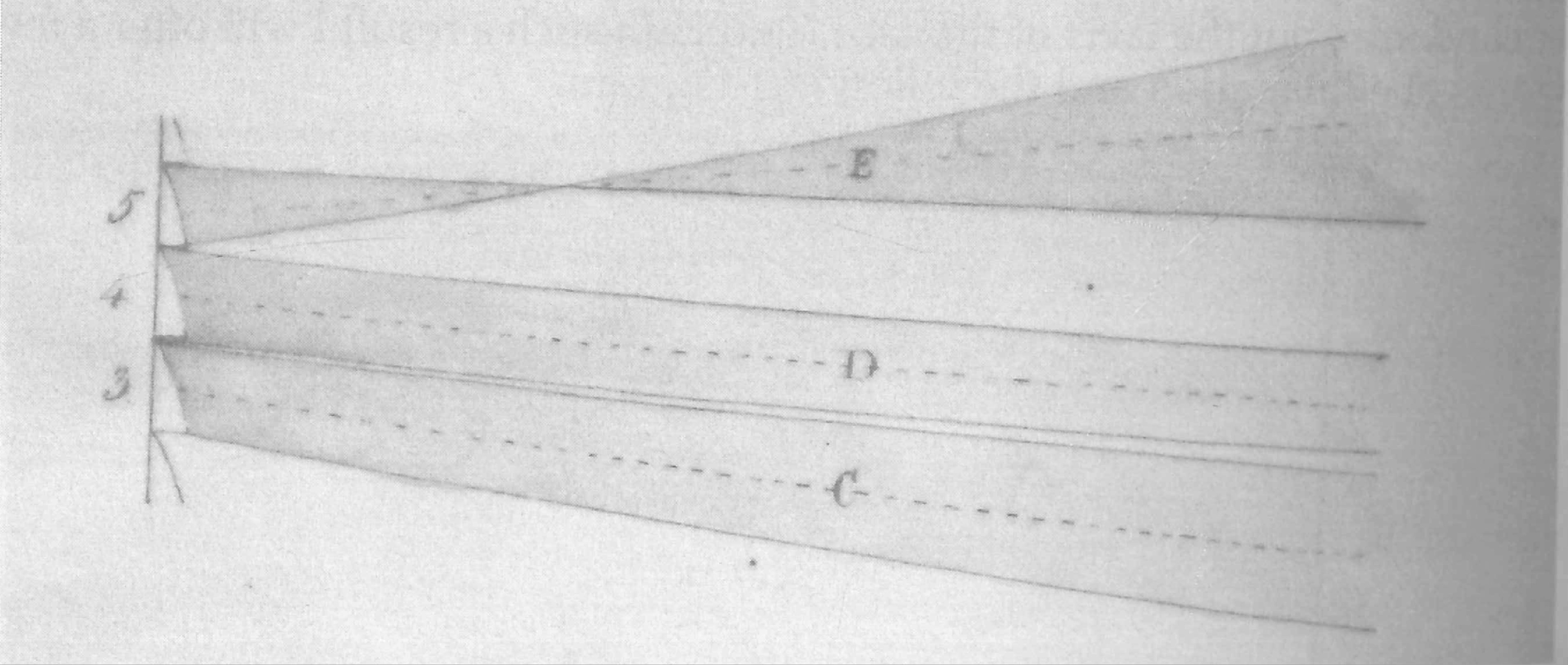
49. I will proceed to give the place of the medium rays for the four different divisions of the French refractor in diagrams; but in these diagrams the horizontal scale is only about one third of the vertical scale so that the real inclinations of the medium rays are only one third of what appear here. If I had taken equal scales for the horizontal and vertical direction, it would have enlarged the diagrams too much. The actual depression or departure from horizontality is easily obtained thus;
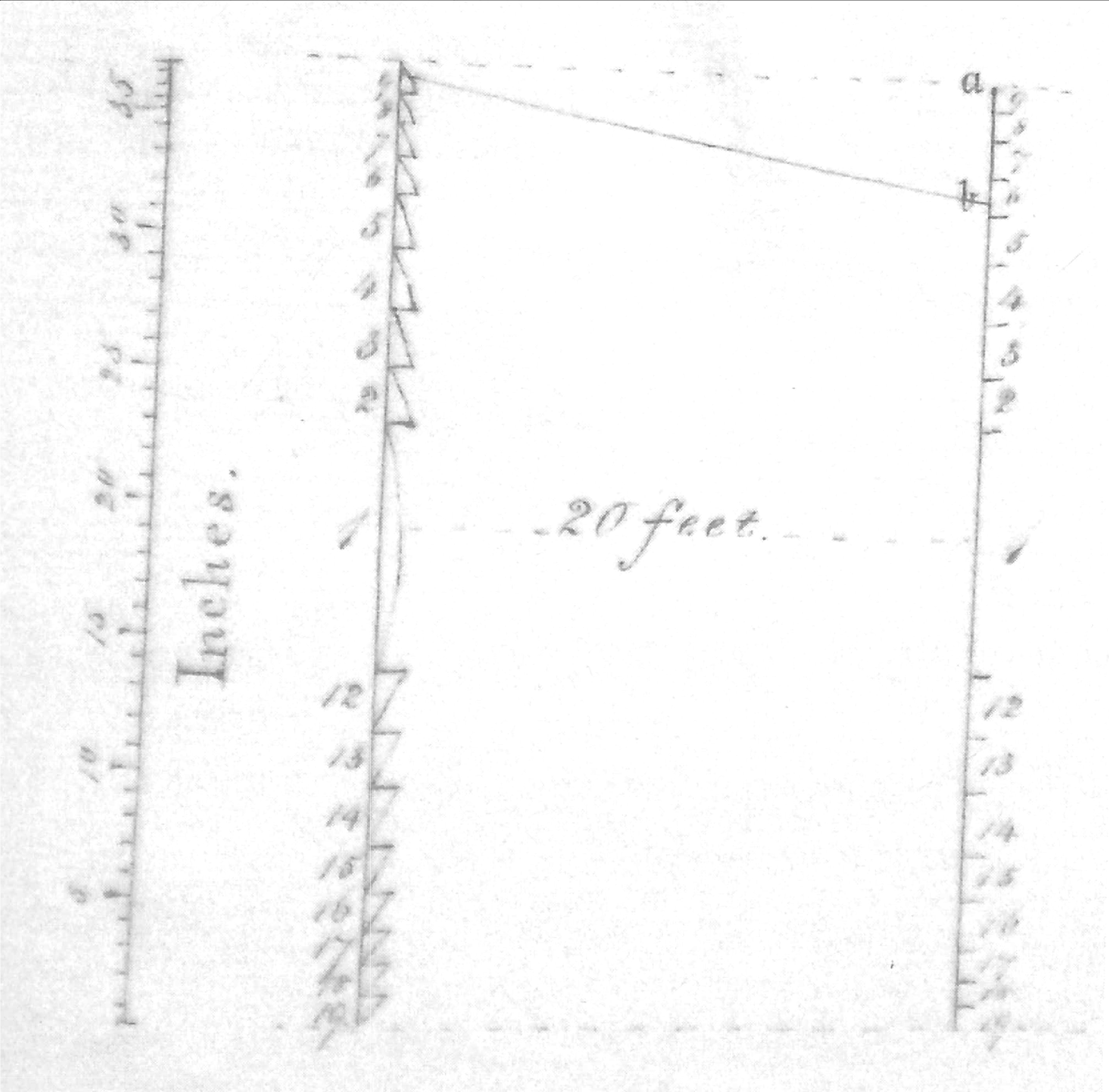
with a pair of compasses applied to the vertical line representing the 20 feet distance, take the distance of any ray from the horizontal point or place where it ought to have fallen; apply the compasses to the vertical scale of inches by the profile of the refractor, and it will give the depression or elevation in inches for 20 feet. Thus the ray from 9. falls some distance below its proper place, and thus distance from a to b, when taken in the compasses and applied to the scale of inches, gives 4½ inches as the depression of that ray in 20 feet; this in 100 feet would become five times as much or 22½ inches and in a mile, 264 times as much, or 99 feet.
50. The following are the places of the medium ray, at the distance of 20 feet, for each of the four divisions of the French refractor at the Trinity House,

51. These lines shew, in a general manner, the direction taken by the rays emanating from a light placed in the given focus; and are quite sufficient as a general record of the value of the refractor in this respect, or for the comparison of one refractor with another.
52. As the lamp used in the lighthouses has many parts of its flame far removed from this focus, and these parts give other directions of the medium rays, I have thought it desirable, with a view to future elucidation, to ascertain the direction of the rays when issuing from points taken so as to represent these extreme parts of the flame. The diagrams in the next page shew these directions, when the object was placed two inches nearer the refractor than the given focus, also two inches further, both these stations G and H being in the same horizontal line with the focus:-

then it was placed ⅝ of an inch below the focus as at I and one inch above the focus as at K. Two other points at right angles with G and H in the horizontal plane were not taken, because, the directions with them would have been very nearly the same as those given by the object in the focus itself.
53. The results at these four stations, being intended for general elucidation of the principles of dioptric arrangements, were not taken with any other than column IV of the French refractor.
54.
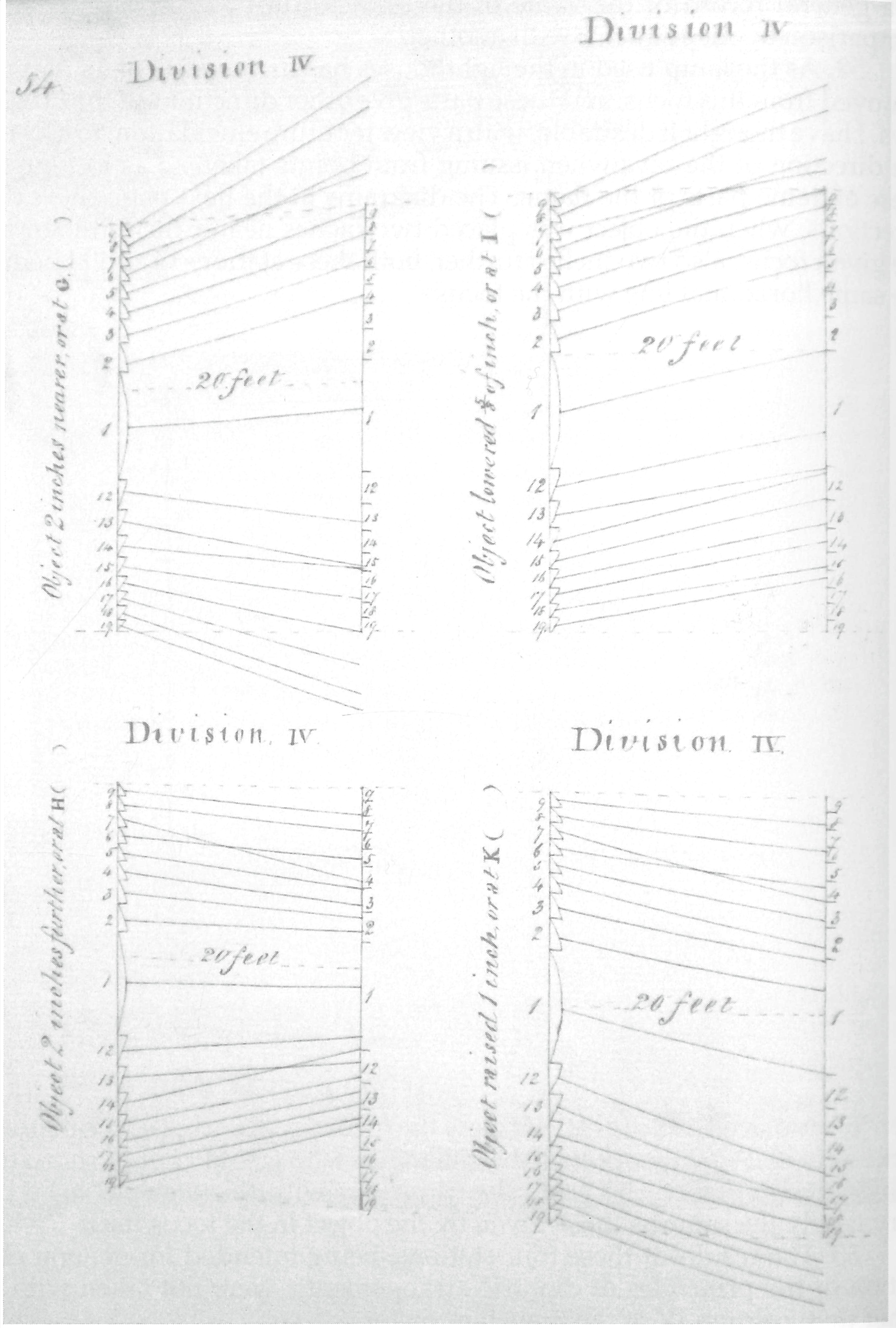
55. Now may be seen the probable reason why the French refractor has it’s lines of medium direction generally ascending <(50)>. The height of ⅝ above the burner is assumed as the height of the focus; but with the usual flame there is more bright part above this point than there is beneath it, and all this part sends rays lower in their medium direction than the parts which are at the height of the focus. It is in fact as if the French had taken a higher point than one, ⅝ of an inch above the burner, as their focus; and such a point accords better with the real centre, as to height, of the flame itself.
<-><-><->
56. Returning to the results given by the mean ray when the object is in the given focus, I will now set down its direction with the English 1st class refractor, at the Trinity House.
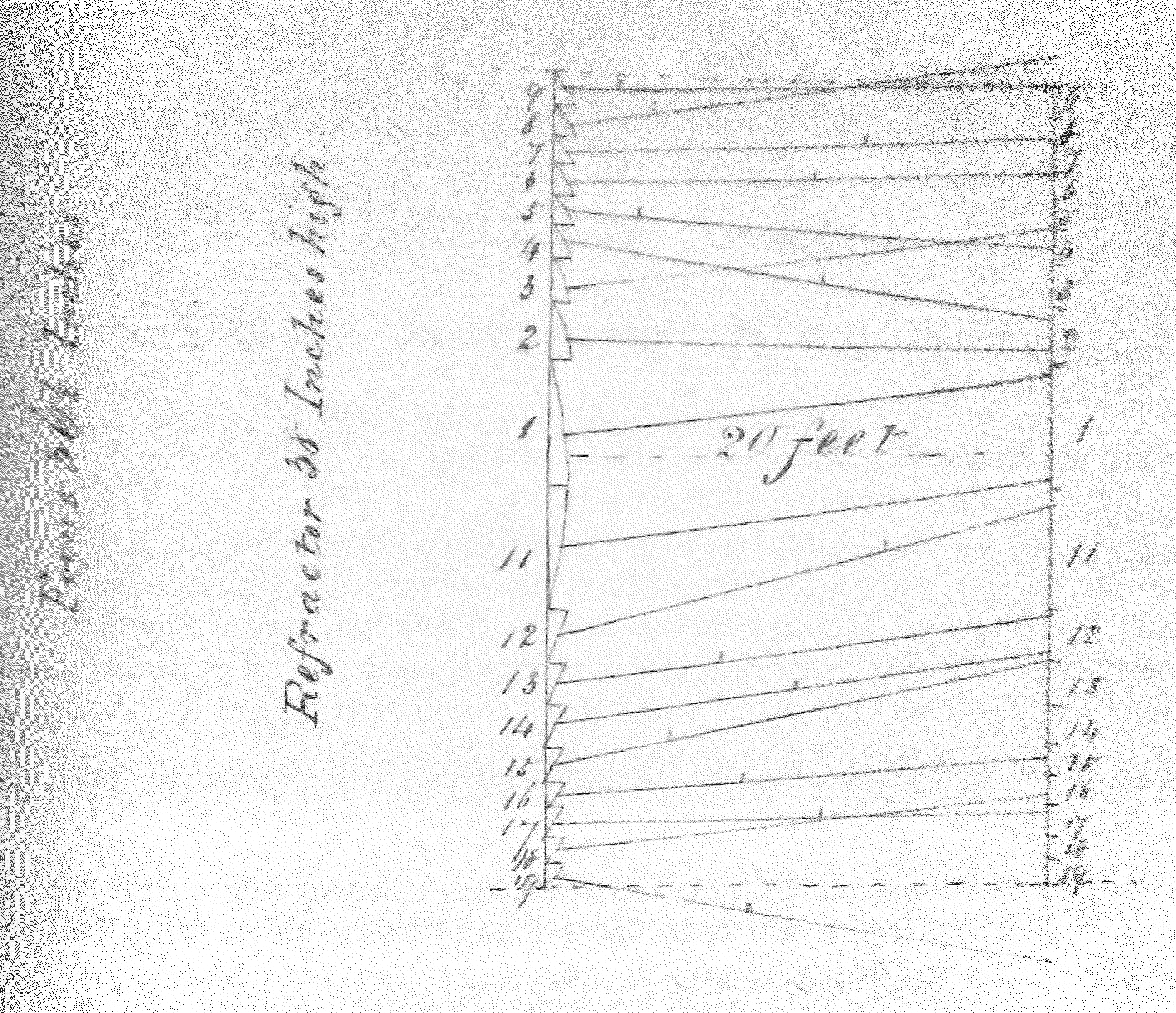
On comparing these lines with those of any of the four divisions of the French refractor (50) it cannot but be seen, that, the departures from parallelism are far greater in the English than in the French instrument.
57. There are two English 2nd Class refractors at the Trinity House. Their given foci are 27.6 inches. The direction of the medium ray is, with them, as follows,
English 2nd Class refractors at the Trinity House.

I need not point out which medium rays are parallel, and which depart much from it.
58. The form of the object (27. 46) is often very bad in these three reflectors, and shews that the single pieces of glass are not worked so as to be consistent with themselves in their action.
59. The apparatus at present at Mr. Wilkin’s Manufactory includes seven refractors and a spare one. These, I have had numbered by punch marks from 51 to 58 inclusive. The apparatus does not revolve, and being in a small workshop, I could only examine, efficiently, frames 53 and 54, and the spare frame 58. The following are the results as to the direction of the medium ray. The images were often very badly shaped <(58)>.
60.

61. I have now pointed out the direction of the medium ray in different frames; it’s use as an indicator of the action of the refractor; and it’s power also of supplying a record of that action. But the medium ray is not sufficient for a full test, if alone. To make it so, it requires to be combined with the individual action of each rib of glass; as will be easily seen by the following diagrams and remarks.
62. Suppose the medium ray M. of a rib to be horizontal, and the object or light placed in the right focus of that rib, as at F; then all the rays passing from the rib will be horizontal,

and the arrangement perfect;- for the divergence of the general beam in a lighthouse is not to be given by the adjustment of the refracting rib so as to throw diverging rays, but is to be obtained by the great size of the lamp flame, which involves the variation of the advancing rays to the extent already shewn in the four positions of the object <(54)>.
63. Or, suppose the medium ray horizontal, but the object or lamp so far out of the true focus as to give rays converging to a

secondary focus at the distance of 40 feet. Then at 40 feet from the refractor in the horizontal line the light would be very powerful; at 80 feet it would be as powerful as if the rays had proceeded parallel; but at distances beyond that it would become weaker faster than it ought to do; and, at 120 feet would be only half as strong as if the rays had gone parallel from the first; at 200 feet only one fourth as strong, at 360 feet only ⅛ as strong, and so on.
64. Or suppose the medium ray horizontal, and the object so far out of the focus as to give a second focus at five feet distance; the effects
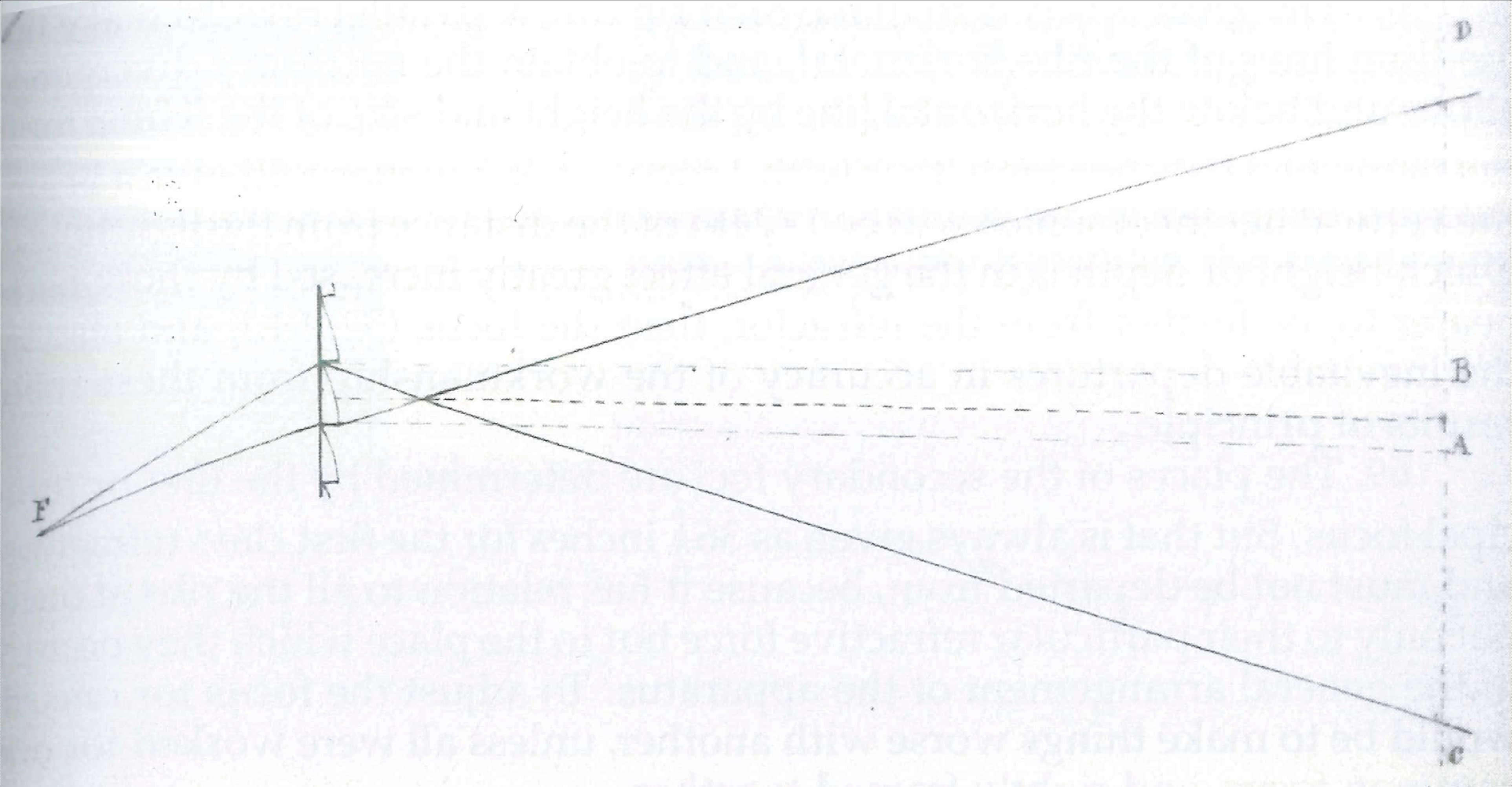
would be the same as those just described but the diminution of light as the distance increased far more rapid.
65. On the other hand, when these secondary foci occur, and are short, then the light can be seen through the rib over a much larger space than if the rays were parallel. Thus, if the rib above were to give parallel rays, the eye in the upright distant line C.D. would see the light only between A and B, and very bright there; whereas, if the emergent rays were refracted as shewn to a short focus, the eye would see their source any where between C and D but the light would be much fainter. (63.)
66. So if a rib gave a depressed medium ray

and refracted the emergent rays to a second focus at G, an eye placed at H in the horizontal line, would now see some light in the bottom edge of the rib; whereas if it had sent parallel rays, i.e. rays parallel to the medium ray, that ray would have been dark to the eye at H.
67. Thus then, when the medium lines are not horizontal, this condition of the ribs may enable them to throw some light, occasionally, into the horizontal plane; but then it involves such rapid loss of light at great distances as to be, on that account, very injurious. (63. 64)
68. The great object is to make each rib throw parallel rays; to make the medium lines of the ribs horizontal, and to obtain the necessary divergence above and below the horizontal line by the height and size of the flame: for it the flame be 1½ inches high, that with a focus of 36½ inches will give a beam, the vertical height of which will be 1/24th of the distance from the lighthouse; which height or depth is in the general effect greatly increased by those parts nearer to, or further from the refractor, than the focus (52. 54.), and also by the inevitable departures in accuracy of the workmanship from these mere results of principle.
69. The places of the secondary foci are determined by the first or principal focus. But that is always given as 36½ inches for the first class refractors, and must not be departed from, because it has relation to all the ribs at once; not only to their particular refractive force but to the place which they occupy in the general arrangement of the apparatus. To adjust the focus for one rib would be to make things worse with another, unless all were worked for one common focus, and rightly framed together.-
70. Now the secondary foci of frame 58, (which being separate is the one I can best examine,) are as follows; I have expressed them by figures, giving the distance from the refractor; and also in a diagram, which exhibits to the eye the general state of things.
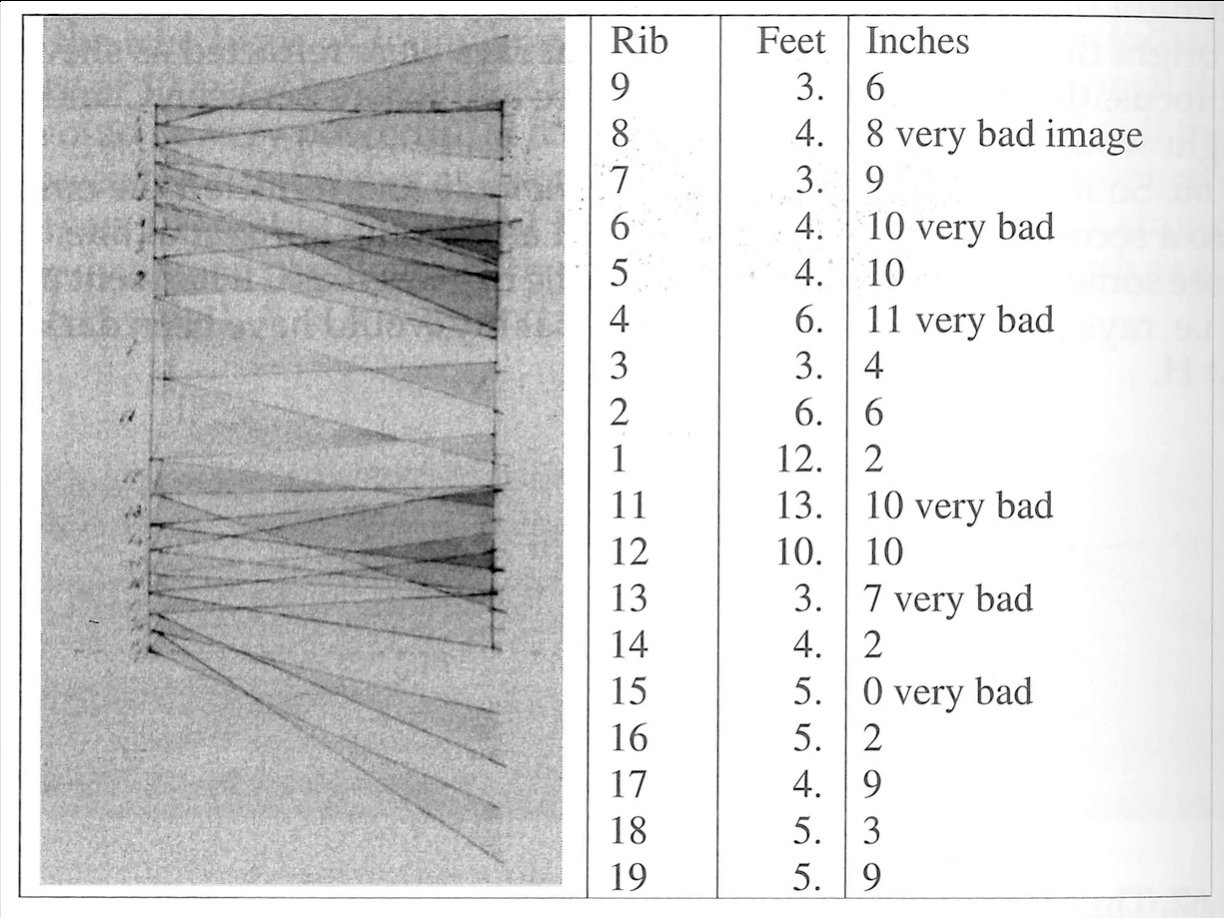
71. These secondary foci are thus observed and ascertained. If the object be in the given first focus and the observer (being at a moderate distance) move the eye up and down, the image of the object will pass across any given bar or prism. If it enter the prism direct (42,) the observer is between the

secondary focus and the refractor, as at A; if it enter the prism reverse <(42)> the observer is beyond the secondary focus as at B. By advancing or retreating a little, he finds a distance at which the object enters over the whole of the width of the prism at once. The object is more or less coloured as this spot is approached, and, at the true spot, any particular colour, as the violet, appears all over the width of the rib at once;- a property by which the spot is very easily identified.
72. Supposing the prism or rib be badly worked and inconsistent with itself, then the image and colours are not so regular, because different parts of the rib act as separate prisms. This is the case with many of the English, and some of the French, ribs; and makes the numbers given only approximations and in some cases very uncertain.
73. I will now give the second foci of frames Nos 53 and 54 in measures. As a further means of recording them, I have marked their length by red ink, on the lines of direction of the medium ray given before (60.) so that thus arranged the diagrams form records of the accuracy or inaccuracy of the different frames.

74. On the next page are the secondary foci of the three English refractors at the Trinity House.
75.

76.

77. With respect to the French refractor, we find the secondary foci very different to those above recorded.

78. To shew this difference more clearly, I will give a diagram of Division IV, to compare with that of Frame, No 58. (70.).

79. I even moved the object into the four extreme positions already mentioned (52. 54.) and ascertained what difference that made with Division IV., to see if it equalled any thing in the English refractors; but such was not the case.

80. I will now conclude this account of the examination of the refractors, hoping to be excused for the length of this report. Considering the importance of the results, I thought it necessary to make the paper a record of the reasons, and in some degree of the principles, on which the conclusions were founded, that it might if necessary be referred to hereafter in explanation of itself. But I have not thought it useful to go into minute parts, as chromatic observations &c: &c:, since they did not affect the general principles and would have embarrassed the statement with unnecessary matter. The measures, (except where the ribs have been of bad shape) though not strict, are near the truth; and on this point I may observe I have not pretended to mathematical, but to useful, precision; for my desire has been to supply a practical method of examination open to all, and capable of being simply and permanently recorded.
81. I believe that the shortness of the secondary foci of the English refractors is a very serious evil, and that the consequent loss of light by dispersion at considerable distances is very great. This is an effect which cannot be perceived by a near observation of the light; for that ray which ought to have gone to a distance may often, by concentration to a nearer place, make the appearance from that place very good. This consideration, and the importance of the results generally, makes me hope that a comparison of the French reflector and the separate English frame No.58. purporting to be of equal power, may be made at the Purfleet lighthouse by observations from Blackwall:- for I am most anxious that the conclusions I have come to should be tested by, and founded on, an efficient experimental result.
82. Those prisms or ribs which give short secondary foci, can easily be made to send, instead, parallel rays, by shortening the principal focus; and the process of examination which I have described gives an easy method of determining what this first focal distance should be. Thus, with frame No.58, I shortened the principal focal distance, until the secondary foci of the two principal ribs 1 and 11 were at the extremity of the room, or about 32 feet, instead of being respectively 12 feet 2 inches and 13 feet 10 inches <(70)>; and to do this I found that the first focal distance had to be diminished by no less than 4 inches and a half, and that was not enough to make the emergent rays parallel. To test this result I placed frame No. 58 in the parallel rays of the sun, and then found that the foci of ribs 1 and 11 were about 31 inches from the refractor instead of 36½ inches. But then they were not together, but were an inch and a half or more separate; and the true foci of the other ribs when thus exhibited were still further separated from these.
83. It is, therefore, impossible in this frame, to find another focus which may be used instead of the given one: because the new place, though better for some ribs, will be worse for others. This may be illustrated by the medium direction and secondary foci of the ribs of frame No. 58, when the object was placed at the new distance of 31 inches.-

84. Here the effects as regards parallelism of the rays from ribs 1 and 11 were the best, and the medium direction not bad; but for the other ribs the secondary foci are still under-corrected, and the medium direction is so divergent as to make them almost useless. A consideration of the lines of medium direction and of the secondary foci in the other frames, shews that the same result would happen with them.
85. The relative lengths of the secondary foci of the middle and principal ribs of the English refractor 1st Class at the Trinity House, and those of No. 58 and the other frames of the Gibraltar apparatus, makes me think it probable that the tools by which the principal pieces of glass are worked have worn out of shape. However that may be, the process of testing, which I have described will supply the manufacturer with the means of examining his work; for he may test the glass ribs separately, both for their focal length and their refracting angle; i.e. their distance from the place of the lamp and also their intended place in the frame, with the utmost facility. He may then select the ribs for any given frame, and, with a little contrivance, the process would also give him ready means of examining his work as he builds up a frame, so that at last it should be in practise, what it professes to be in principle and, equal in goodness to any given acknowledged standard.
86. I have not yet attended to the mirrors. The desire to be correct in this first statement of the general results of the proposed mode of examination, has made me anxious to repeat observations, and has consumed time in a degree, that will be quite unnecessary in future cases; but I shall shortly have the honor of reporting results with respect to them.
I have the honor to be | My Lords and Gentlemen, | Your most obedient humble Servant, | (signed) M. Faraday.
Royal Institution | 28th August 1840.
Please cite as “Faraday1310a,” in Ɛpsilon: The Michael Faraday Collection accessed on 27 April 2024, https://epsilon.ac.uk/view/faraday/letters/Faraday1310a